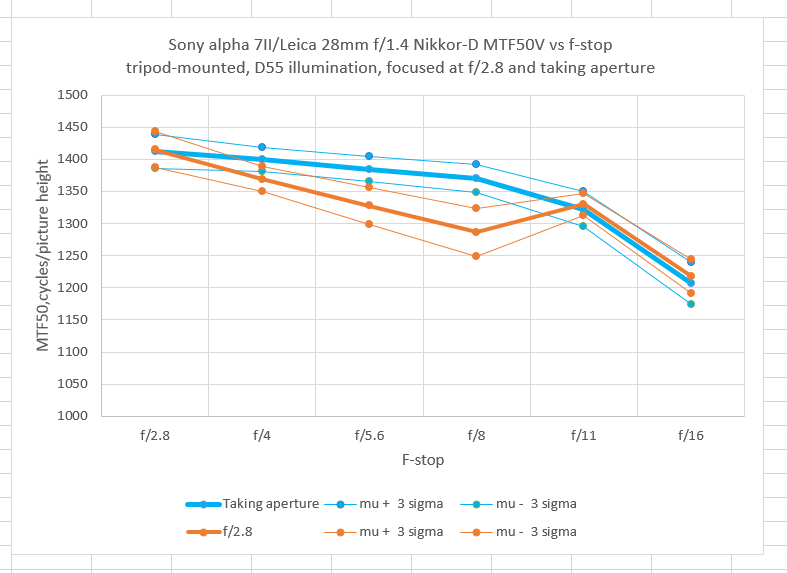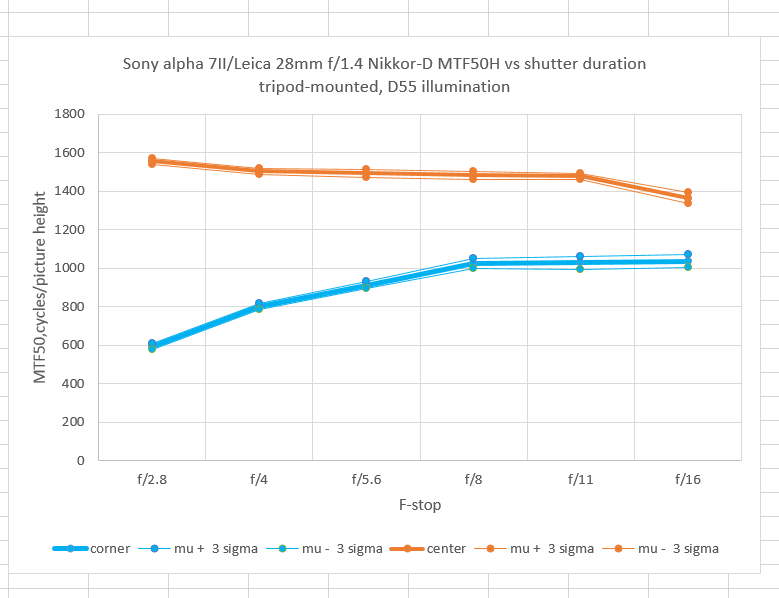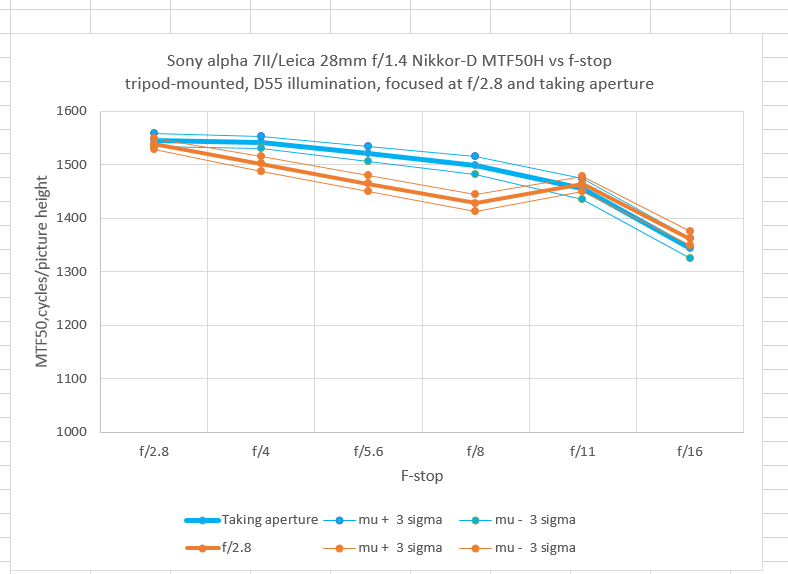Jack Hogan suggested that some of the unusual results for the Nikon 28mm f/1.4, and possibly the Leice 28mm Elmarit-R, might be due to focus shift, since I did all my focusing at f/2.8.
Here’s a test with the Nikon lens. I did one 96-shot series (16 shots each at 6 f-stops) focusing as before. I changed the orientation of the edge that I’m using from horizontal to vertical just to get another look.
Then I did another series, focusing once at the taking aperture. I thought I would have to focus each image independently, but I was able to obtain accurate focus on the Siemens star on the target by using a bright focusing light (turned off for the actual exposures so that it wouldn’t contribute to the exposure). I had been focusing using the modeling light on the strobe, but that just wasn’t repeatable at small apertures. I used different amounts of focus peaking at different apertures, and could see just from that that f/2.8 was the sharpest aperture, but not by much.
By the way, the vertical elements of the SIemens star lit up like a Christmas tree while he horizontal elements remained dark. But we know that the AA filter on the a7II is anisotropic the other way. That leads me to believe that the focus peaking in the camera is strongly tuned to be sensitive to vertical lines, and is relatively insensitive to horizontal ones.
The results:
The blue curves are for focusing at the taking aperture, and the orage ones are for focusing at f/2.8. The remarkable alignment of the f/2.8 results is not because I dry-labbed them and used the same data; each is the result of its own set of 16 exposures. The thin lines are at the mean pous and minus three standard deviations.
It looks like there is focus shift at f/4 through f/8. It’s not bad, but it’s there. This is not a happy development for me, since I can’t reliably focus at the taking aperture in the field under most circumstances. I guess I could carry around a focusing target. Hmmm…
For reference, here are the curves from the previous post:
The shape of the orange curve on the graph immediately above should be the same of the blue curve on the top graph. It isn’t.
I went back and did the calculations for the same horizontal edges:
That doesn’t explain it. It looks like there’s some difficulty achieving the same setup, even though the three-sigma lines indicate tight repeatability. Of course, they only apply within a given setup.
The big surprise of the first round of testin was the f/2.8 was the best aperture for the lens. That held up, but barely, and f/4 is in a virtual dead heat. Actually, from f/2.8 though f/11, there’s not enough difference to matter in the field. Even f/16 is eminently usable.



Go figure, some focus shift ( I would not worry about it if shooting hand held) but still no peak around f/5.6. Could it be the adapter?
How could it be the adapter? Oh, lemme check for internal focusing on that lens.
Ah, yes: http://www.photozone.de/nikon_ff/723-nikkorafd2814ff
The adapter is short, like all adapters.
Sounds like you nailed it, Jack.
Jim
Dear mr. Kasson,
How about a compromise, for taking real pictures in the field, and try to focus at f/4 or f/4.8, where you can still get reliable focus under most circumstances? It will be nice to see what happens to focus shift when focusing at f/4 and take the picture at f/8…
Regards
FAS
That’s a good idea. I’ve already moved somewhat in that direction by focusing at f/2.8 rather than f/1.4.
I stay tuned then 🙂
While i have not Nikkor’s 1.4/28, it’s useful to know for other “focus-shifting” lenses too. Usually I focus between f/2.8 and f/4 with fast wide-angles lenses if I plan to shoot at smaller apertures, but now I’m thinking to switch past f/4.